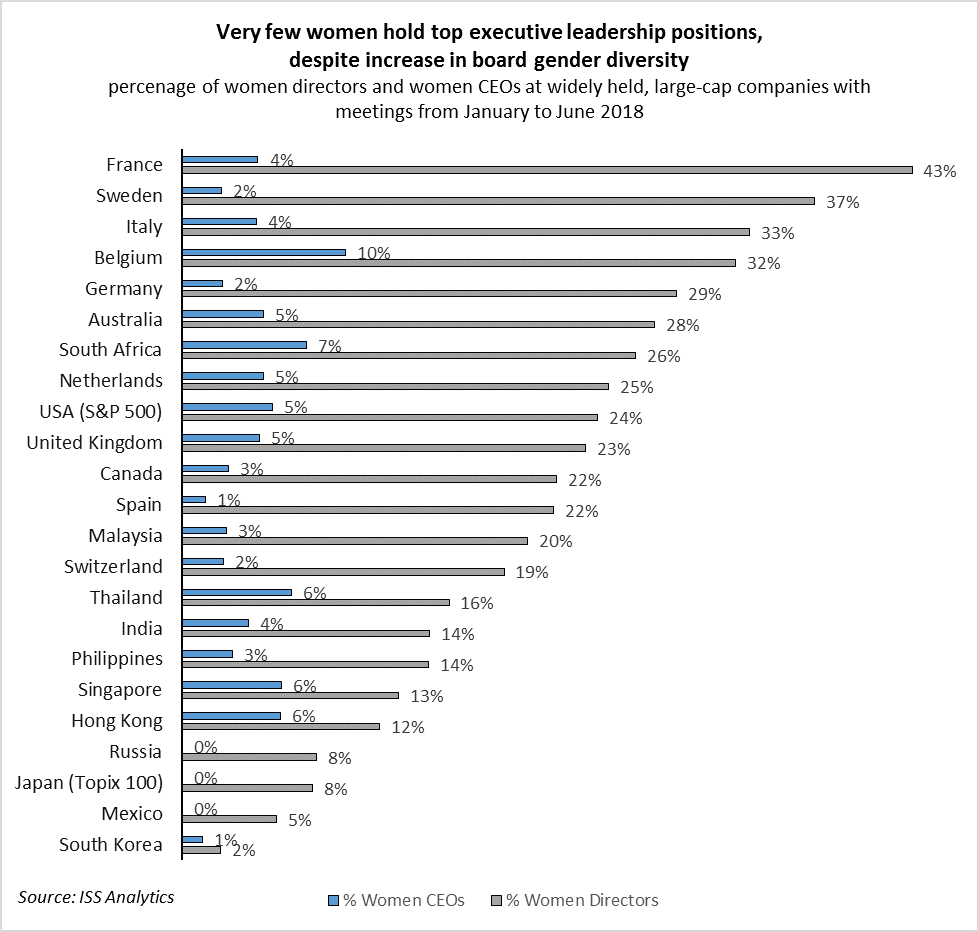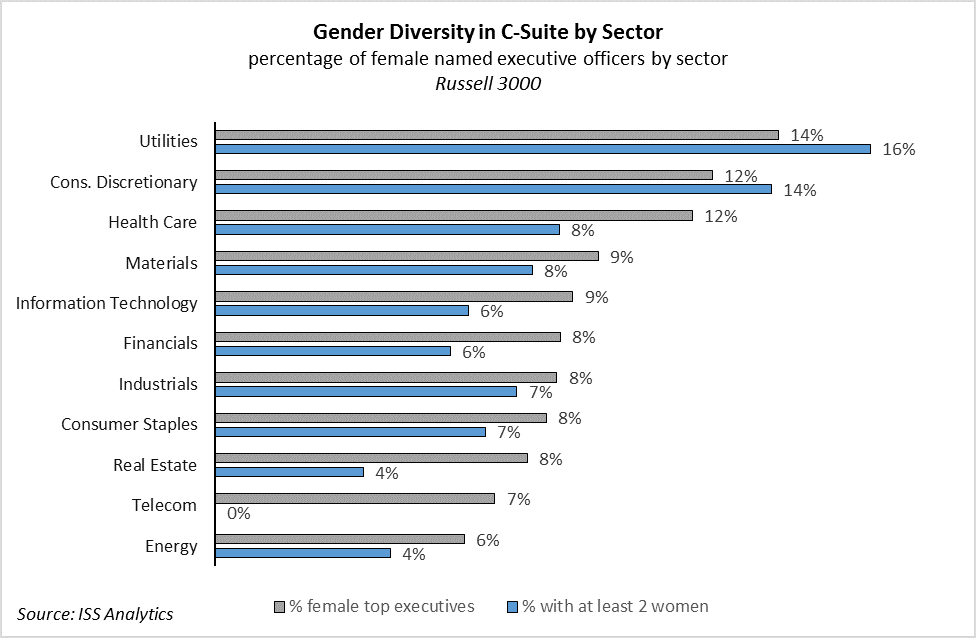Subodh Mishra is Executive Director at Institutional Shareholder Services, Inc. This post is based on an ISS Analytics publication by Kosmas Papadopoulos, Managing Editor at ISS Analytics.
Despite recent advances in female board participation globally, gender diversity among top executives remains disappointingly low across all markets, with some improvement discerned in the past few years. Moreover, there does not appear a correlation between board gender diversity and gender diversity in the C-Suite at the market level. Some of the markets that have implemented gender quotas on boards and have achieved the highest rates of female board participation, such as France, Sweden, and Germany, appear to have embarrassingly low rates of female top executives. In fact, many of the markets with progressive board diversity policies have lower gender diversity levels in executive positions compared to several emerging markets like South Africa, Singapore, and Thailand. Thus, achieving higher rates of gender diversity in the C-Suite will require deeper cultural shifts within organizations in order to overcome potential biases and hurdles to gender equality.
The number of female top executives remains low
In the past decade, gender quotas, policy initiatives, and—more recently—investor pressure have led to boards improving female board participation in Europe and North America significantly. The percentage of female directors in the Russell 3000 increased from 10 percent in 2008 to 18 percent in 2018, with most of the increase taking place since 2013. Similarly, the percentage of female directors in ISS’s core universe of widely-held European firms more than tripled from 8 percent in 2008 to 27 percent in 2018. While the recent push by policymakers, investors, and advocacy groups for greater gender diversity has primarily focused on board positions, the discussion is beginning to evolve to encompass diversity in all leadership roles, including top management. In the United States, we have observed small but significant changes in the gender composition of the C-Suite over the past five years. Since 2012, the Russell 3000 has seen a 70-percent increase in the number of female CEOs. Despite the relative increase, the number of top female executives remains disappointingly low, with only 5 percent of Russell 3000 companies having a female CEO in 2018.
Companies need to develop the pipeline of female executive leaders
The scarcity of female CEOs does not appear surprising, especially after taking a closer look at the rest of the members of the C-Suite, who often comprise the primary candidates in line for succession for the top job. These roles include the Chief Operating Officer, the Chief Financial Officer, and the Head of Sales, among others. Only 9 percent of top executive positions in the Russell 3000 are filled by women, which means that companies have a long way to go towards building gender equity within the top ranks where the next generation of CEOs are cultivated. Certain sectors lag considerably more than others, with Real Estate, Telecommunications and Energy exhibiting the lowest rates of female named executive officers.
Within the C-Suite, gender differentiation persists in terms of executive roles
The picture seems even bleaker for the future of gender parity at the CEO level when examining the types of roles that female top executives currently occupy within their organizations. Female executives appear scarcer at roles with profit-and-loss responsibilities that often serve as stepping stones to the CEO role, such as COO, Head of Sales, or CEOs of business units and subsidiary groups. Meanwhile, women are more highly concentrated in positions that rarely see a promotion to the top job, such as Human Resources Officer, General Counsel, and Chief Administrative Officer.
Not surprisingly, and in conjunction with the disparity in functions described above, women who belong to the group of the five highest paid executive officers in their organization, are far more likely to rank fourth or fifth in pay rank compared to their male counterparts. Approximately 46 percent of women in the top five positions rank either fourth or fifth in pay, compared to 33 percent of male top five executives in these pay rankings.
Breaking down barriers to gender diversity in the C-Suite
Companies can take a number steps to foster gender diversity in their executive leadership, and to remove biases or potential obstacles to an inclusive management environment. Many companies have identified gender diversity in leadership positions as a key priority, and have established gender diversity strategies to achieve specific goals. While workforce diversity policies appear to become the standard across most markets, gender diversity policies at the senior management level are common only in some markets. According to ISS Environmental & Social QualityScore data, the majority of companies in developed European markets and Canada disclose gender diversity policies for senior managers. The practice has not been widely established United States, where 32 percent of the S&P 500 and only 4 percent of the remaining Russell 3000 disclose such policies.
Several companies and advocacy groups identify gender diversity and inclusion as a major driver for talent acquisition and performance. The recognition of the absence of women in top executive roles has sparked several initiatives that seek to promote inclusivity in the workplace. The Rockefeller Foundation’s 100×25 advocacy initiative aims at bringing more women to the C-Suite, with the explicit goal of having 100 Fortune 500 female CEOs by 2025. Meanwhile, Paradigm for Parity was formed by a coalition of business leaders (CEOs, founders, and board members), and set the goal of achieving full gender parity by 2030. The group has created a 5-point action plan to help companies accelerate their progress.
Based on the work of these initiatives and actual programs disclosed by companies, we identify five of the emerging best practices that companies adopt to address gender diversity in leadership roles.
- Address subtle or unconscious bias. Cultivating a strong culture free of subtle or unconscious bias is a fundamental step towards an inclusive work environment. A meta-analysis by the Harvard Business Review finds that subtle discrimination has as negative effects, if not more negative, than overt discrimination, as it can drain emotional and cognitive resources, it can accumulate quickly, and is difficult to address through legal recourse. The researchers suggest that structured processes and procedures around hiring, assignments, and business decisions limit the opportunity for unconscious bias to creep in. In addition, they suggest training programs and practicing techniques, such as mindfulness, to reduce bias.
- Establish clear diversity targets and measure progress towards goals. Most companies with gender diversity strategies set clear, measurable targets. BP has set a goal of women representing at least 25 percent of its group leaders by 2020, while Symantec aims at having 30 percent of leadership roles occupied by women by the same year. This approach allows firms to focus on concrete performance results, while also creating a framework of accountability in the company’s gender diversity and inclusion program.
- Focus on key roles and redefine the path to leadership. True meritocracy should determine the criteria for leadership roles. However, companies should recognize that there may be multiple paths to the CEO position, and should focus on their efforts on roles that lead to those paths. Women CEOs Speak, A Korn Ferry Institute study supported by the Rockefeller Foundation, identifies four different career approaches for women to prepare for the CEO role. However, the study identifies early assumption of profit-and-loss responsibilities in all four paths as a crucial experience leading to top positions.
- Establish mentorship and sponsorship programs. Training and development programs within the organization can help facilitate mentorships and sponsorships, which are crucial in career development. GM’s Diversity and Inclusion Report explains how its Executive Leadership Program aims at creating a support network of female leaders, as well as training and development sessions hosted by female executives. Mentors can support employees earlier in their career with coaching and advice, while sponsors take a more active role later in one’s career to promote the individual. Gender should obviously not constitute a barrier for such mentorships and sponsorships, and organizations should take active steps to encourage such relationships across genders and remove any hesitations or biases.
- Provide flexibility and support towards work-life balance. Top executive assignments often involve significant time commitments and travel that can impact an executive’s family life. In a New York Times news analysis, former McDonald’s executive Janice Fields, identified her choice not to work overseas as a handicap to becoming the CEO. Making accommodations in relation family, including both children and spouses, can remove some significant hurdles for women.
 Print
Print





One Comment
A great read with aspects for us to discuss at next D&I Meeting SFS UK. It’s encouraging that Siemens already has succession planning programme in place for women and flex working.